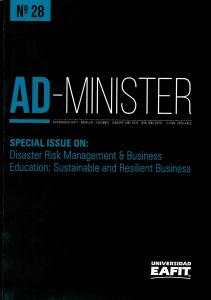Mainstreaming disaster risk management in higher education
Main Article Content
Keywords
disaster risk management, higher education, Mexico
Abstract
Universities should actively participate in disseminating and fostering a culture for disaster risk management (DRM) among students and the community. Particularly in countries with high levels of risk, education plays a key role in raising awareness on the importance of preventing and implementing conscious risk management. Though the incorporation of DRM into the curricula, education programs become a mechanism to prepare students from a perspective of strengthening of values, citizenship, and social sensibility towards how disaster represents a disruption of the functioning of a community and impairs business activity. This paper presents the proposal for the integration of DRM of a private university in Mexico, one of the countries particularly susceptible to extreme hydrometereological and geological events. The proposal includes a concentration area for undergraduate business students, a mandatory introductory course for all business majors, and
for the business community an executive education program for SMEs.
Downloads
References
AMIS. (n.d.). Concurso interuniversitario 2016. Retrieved from: http://www.amis.com.mx/amis/blog/concurso_2016.html
Banco de México. (2015). Reporte sobre las condiciones de competencia en el otorgamiento de crédito a las pequeñas y medianas empresas (PYME). Retrieved from: http://www.banxico.org.mx
Boyles, T. (2012) 21st century knowledge, skills, and abilities and entrepreneurial competences: a model for undergraduate entrepreneurship education. Journal of Entrepreneurship Education, 15, 41-55.
Cardona, O. (2004). The need for rethinking the concepts of vulnerability and risk from a holistic perspective: a necessary review and criticism for effective risk management. In G. Bankoff, G. Frerks, and D. Hilhorst (Eds.), Mapping Vulnerability: Disasters, Development and People (pp. 37-51). London: Earthscan Publishers.
CENAPRED. (2015). Impacto socioeconómico de los desastres en México durante 2014. Retrieved from: http://www.cenapred.gob.mx
CENAPRED. (n.d.). CENAPRED. Retrieved from http://www.cenapred.unam.mx/es/
Clarke, C. (2003). Foreword of the Secretary of State for Education and Skills for the Whitepaper The future of the Higher Education. Retrieved from: http://webarchive.nationalarchives.gov.uk
CONACYT. (2015). Participa en KUXTAL videojuegos 2016. Retrieved from: http://www.conacytprensa.mx
Conrow, E. (2003). Effective risk management: some keys to success. Reston, VA: American Institute of Aeronautics and Astronautics.
Dettmer, J. (2002). Educación y desastres: reflexiones sobre el caso de México. Revista Latinoamericana de Estudios Educativos, 2(2), 43-72.
ENCSH. (2011). Quienes somos. Retrieved from http://www.encsh.itesm.mx
FORBES. (2016, March 8). Mexicanos ganan segundo lugar en concurso de startups en EU. Retrieved from http:// www.forbes.com.mx/mexicanos-ganan-segundo-lugar-en-concurso-de-startups-en-eu/
Foro Ambiental. (2016). A 18 años del huracán ''Paulina'' seguimos sin respetar a la naturaleza. Retrieved from: http://foroambiental.com.mx
Gaete, R. (2011). La responsabilidad social universitaria como desafío para la gestión estratégica de la educación superior: el caso de España. Revista de Educación, 355, 109-133. Retrieved from: http://www.revistaeducacion.educacion.es/re355_05.html
GDRC. (2003). Disaster reduction and sustainable development: understanding the links between vulnerability and risk to disasters related to development and environment. Retrieved from: http://www.gdrc.org
IFRC. (n.d.). Disaster and crisis management. Retrieved from: http://www.ifrc.org
INDESOL. (2015). Cultura de protección civil y prevención de desastres. Retrieved from: http://www.indesol. gob.mx
INEGI. (2014). Censos económicos 2014. Retrieved from: http://internet.contenidos.inegi.org.mx
INFORM. (2016). Index for risk management, results 2016. Retrieved from: http://www.inform-index.org
IPCC. (2012). Managing the risks of extreme events and disasters to advance climate change adaptation. Retrieved from: https://www.ipcc.ch/pdf/special-reports/srex/SREX_Full_Report.pdf
Laredo, P. (2007). Toward a third mission for universities. Paris: UNESCO.
Liu, Z., Xu, J. & Han, B. (2013). Small and medium-sized enterprise post-disaster reconstruction management patterns and application. Natural Hazards, 68(2)809-835. DOI: 10.1007/s11069-013-0657-3
ProMéxico. (2014). PYMES, eslabón fundamental para el crecimiento en México. Retrieved from: http://www.promexico.gob.mx.
Shaw, R. Mallick, F., & Takeuchi,Y. (2011). Essentials of higher education in disaster risk reduction: prospects and challenges. In W. Waugh (Ed.), Community, Environment and Disaster Risk Management Vol 7, (95-113). Bingley: Emerald Group Publishing.
Smith, M. (2009). Psychological foundations of supply chain risk management. In G. Zsidisin and B. Ritchie (Eds.), Supply Chain Risk: a handbook of assessment, management, and performance (219-233). New York: Springer.
UNIRED. (2016). Historia. Retrieved from: http://unired.mty.itesm.mx/?page_id=12
UNISDR. (2013a). Global assessment report on disaster risk reduction (GAR). Retrieved from: http://www.preventionweb.net/english/hyogo/gar/2013/en/home/index.html
UNISDR. (2013b). Del riesgo compartido a un valor compartido:: un argumento empresarial a favor de la reducción del riesgo de desastres. Retrieved from: http://www.preventionweb.net/english/hyogo/gar/2013/en/gar-pdf/GAR13_PressKit_ES.pdf
UNISDR (2015a). Disaster risk management. Retrieved from: http://www.un-spider.org/risks-and-disasters/disaster-risk-management
UNISDR. (2015b). HFA-Pedia: Introduction. Retrieved from: http://eird.org/wikiesp/index.php/Portada
United Nations. (2013a). Del riesgo compartido a un valor compartido: un argumento empresarial a favor de la reducción del riesgo de desastres. Retrieved from http://www.preventionweb.net
United Nations. (2013b). Global assessment report on disaster risk reduction. Retrieved from: http://www.preventionweb.net/english/hyogo/gar/2013/en/gar-pdf/GAR2013_EN.pdf
Vallaeys, F. (2014). La responsabilidad social universitaria: un nuevo modelo universitario contra la mercantilización. Revista Iberoamericana de Educación Superior, 5(12), 105-117. Retrieved from: http://www.scielo.org.mx/scielo.php?script=sci_arttext&pid=S2007-28722014000100006
WHO. (2007). World health report 2007. Retrieved from: http://www.who.int
World Bank. (2012). FONDEN: Mexico´s natural disaster fund, a review. Retrieved from: http://proteccioncivil.gob.mx
World Bank. (2014). Risk and opportunity: managing risk for development. Retrieved from: http://siteresources.worldbank.org
World Disasters Report. (2015). World Disaster Report. Retrieved from: https://ifrc-media.org

